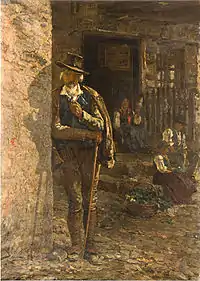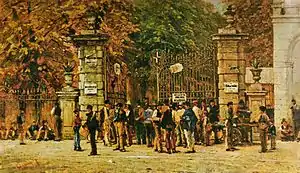Filippo Carcano
Filippo Carcano (Milan, 1840–1914) was an Italian painter.


Biography
A pupil of Francesco Hayez at the Brera Academy in Milan as from 1855, Carcano won the Canonica Prize with a work on a historical subject in 1862, while experimenting in the same period with painting from life. Carcano became friends with Francesco Filippini and Eugenio Gignous, with whom he would sometimes go to paint in Gignese. His interest in themes connected with reality is confirmed in subsequent works presenting scenes of an immediacy that reflects the contemporary developments in the field of the photography. One example is Break Time during Work on the Exhibition of 1881[1] (1887, Galleria d’Arte Moderna, Milan), presented at the Esposizione Nazionale di Belle Arti di Milano in 1881.
A leading figure in the school of Lombard Naturalism, he combined scenes of everyday life with numerous landscapes, featuring the surroundings of Lake Maggiore and the Mottarone as from the 1870s and the mountain peaks on the border with Switzerland at the end of the century. It was in the same period that he took up Symbolism, winning the Prince Umberto Prize at the Milan Triennale of 1897. Among his pupils was Umberto Bazzoli. One of his Works is by Museo Cantonale d'Arte of Lugano.[2] The earthen tones and proletarian thematics often recall the works of Giuseppe Pellizza da Volpedo.
References
- Laura Casone, Filippo Carcano, online catalogue Artgate by Fondazione Cariplo, 2010, CC BY-SA (source for the first revision of this article).
- L'ora di riposo durante i lavori dell'Esposizione del 1881
- Museo Cantonale d'Arte, Lugano: Filippo Carcano
External links
 Media related to Filippo Carcano at Wikimedia Commons
Media related to Filippo Carcano at Wikimedia Commons- Works by or about Filippo Carcano at Internet Archive